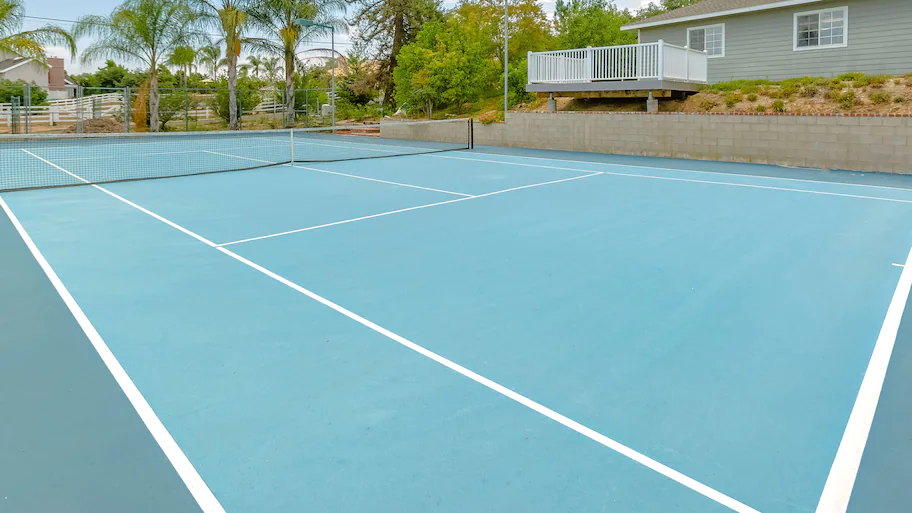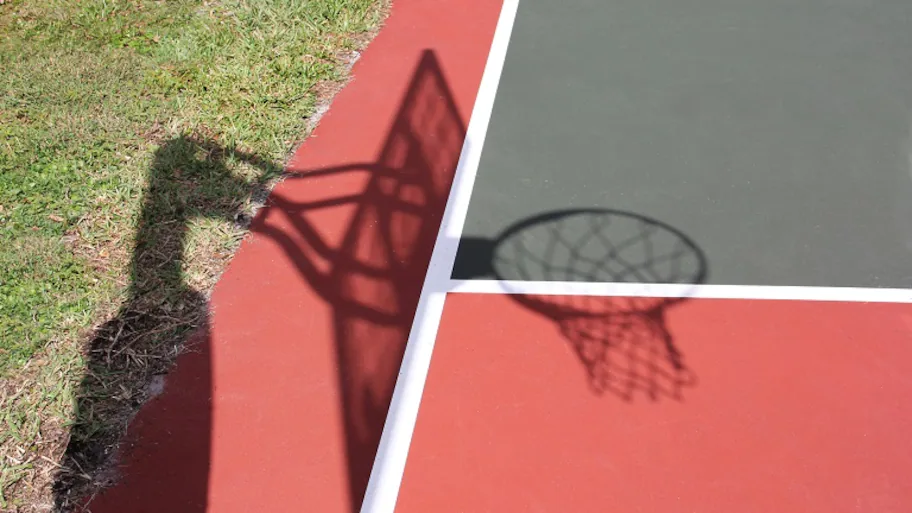Standard Tennis Court Dimensions: What’s the Right Size for My Home?
The perfect tennis court size is literally a game-changer
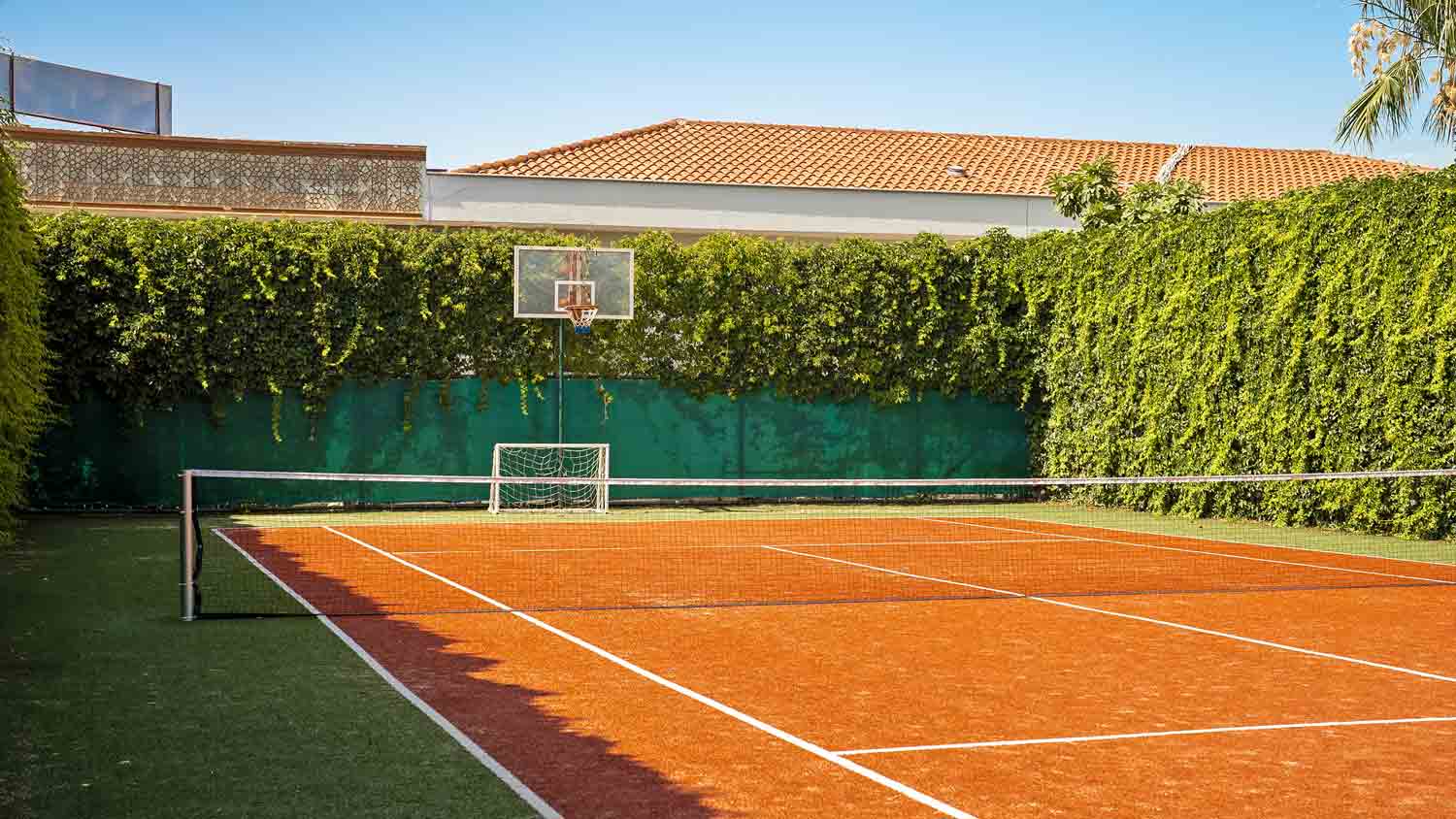

Whether you're building a backyard court or planning a professional installation, choosing the right tennis court size is essential for proper gameplay and functionality. Standard court sizes are determined by organizations like the International Tennis Federation (ITF) and the United States Tennis Association (USTA), but variations exist for different play levels and spaces. Use this guide to learn all about common tennis court dimensions, factors that influence size selection, and how to ensure you have the correct measurements before construction starts.
What Is the Standard Tennis Court Size?
According to the USTA, standard regulation tennis courts are 78 feet long and 36 feet wide for doubles matches and 78 feet long and 27 feet wide for singles matches. A net that is 42 inches high at the posts and 36 inches at the center divides the court into two halves.
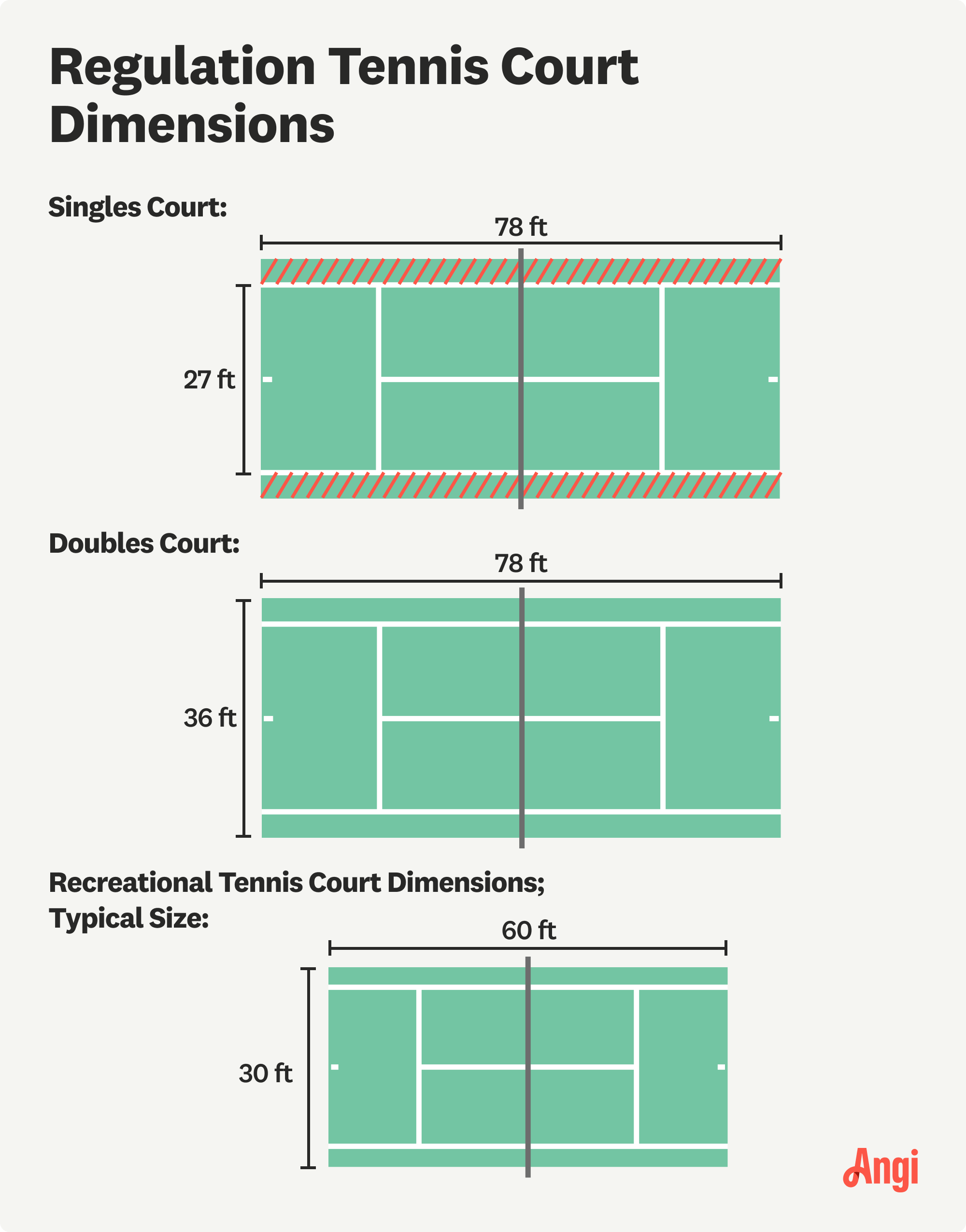
Tennis Court Size by Type
Tennis courts come in different sizes depending on whether they’re for professional tournaments, recreational play, or junior training. The dimensions can significantly impact the game, influencing everything from player movement to the ball’s bounce. For that reason, regulation courts need to meet strict standards set by governing bodies like the USTA and ITF, but recreational and backyard courts can be adapted to fit different spaces and needs.
| Type of Court | Length (ft) | Width (ft) |
|---|---|---|
| Regulation Singles | 78 | 27 |
| Regulation Doubles | 78 | 36 |
| Regulation Junior Singles (9 & 10) | 60 | 21 |
| Regulation Junior Doubles (9 & 10 Years Old) | 60 | 27 |
| Regulation Junior (8 and Under) | 36 | 18 |
| Recreational | 60 | 30 |
Regulation Adult Tennis Court Dimensions
Regulation courts must meet official standards set by the ITF and USTA. A singles court needs to be 78 feet by 27 feet, while a doubles court must be 78 feet by 36 feet. Courts also require an additional clearance of 21 feet behind the baseline and 12 feet on each side to ensure safe movement and ballplay for players.
Regulation Junior Tennis Court Dimensions
Regulation junior tennis courts also need to follow USTA guidelines. For children 8 years old and under, courts must be 36 feet by 18 feet, with a lower net height to match their skill level. For children ages 9 and 10, the court expands to 60 feet by 21 feet for singles and 60 feet by 27 feet for doubles.
Recreational Tennis Court Dimensions
No rules dictate how big or small a recreational tennis court should be, so sizes vary quite a bit. However, many backyard recreational courts are around 60 feet by 30 feet. While smaller than regulation courts, this size still allows for comfortable singles and doubles play.
How to Measure the Right Size Tennis Court
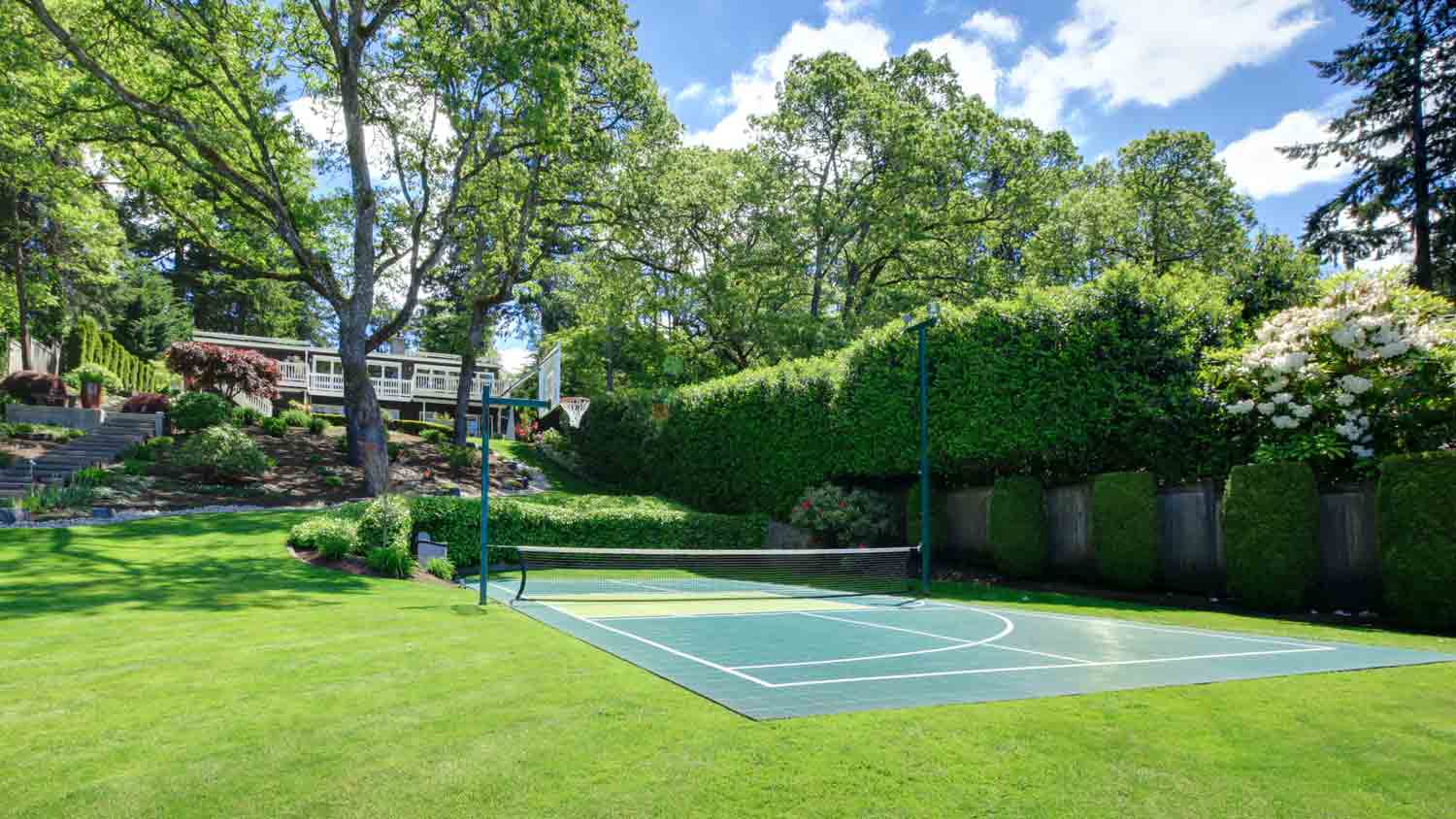
Whether you’re installing a regulation court or a recreational one, taking accurate measurements from the start prevents costly mistakes later.
Measure the Playing Area: Use chalk or stakes and string to outline the court’s perimeter. If you’re building a full-size court, mark off the standard length and width. If you’re going for a recreational or junior court, adjust the dimensions to fit your available space.
Measure the Clearance: A tennis court isn’t just the playing area—you also need room around it so players can move safely. Use a tape measure to mark the clearance behind the baselines and along the sides. Regulation courts require 21 feet of clearance behind the baseline and 12 feet on each side. If you’re working with a tight space, aim for as much room as possible to prevent walls, fences, or other obstacles from interfering with play.
Mark the Net Posts: Each net post should be in the center of the court, about three feet outside of each sideline. Mark it using chalk, tape, or string. The net height should be 42 inches at each post and 36 inches at the center.
Factors That Influence Tennis Court Size
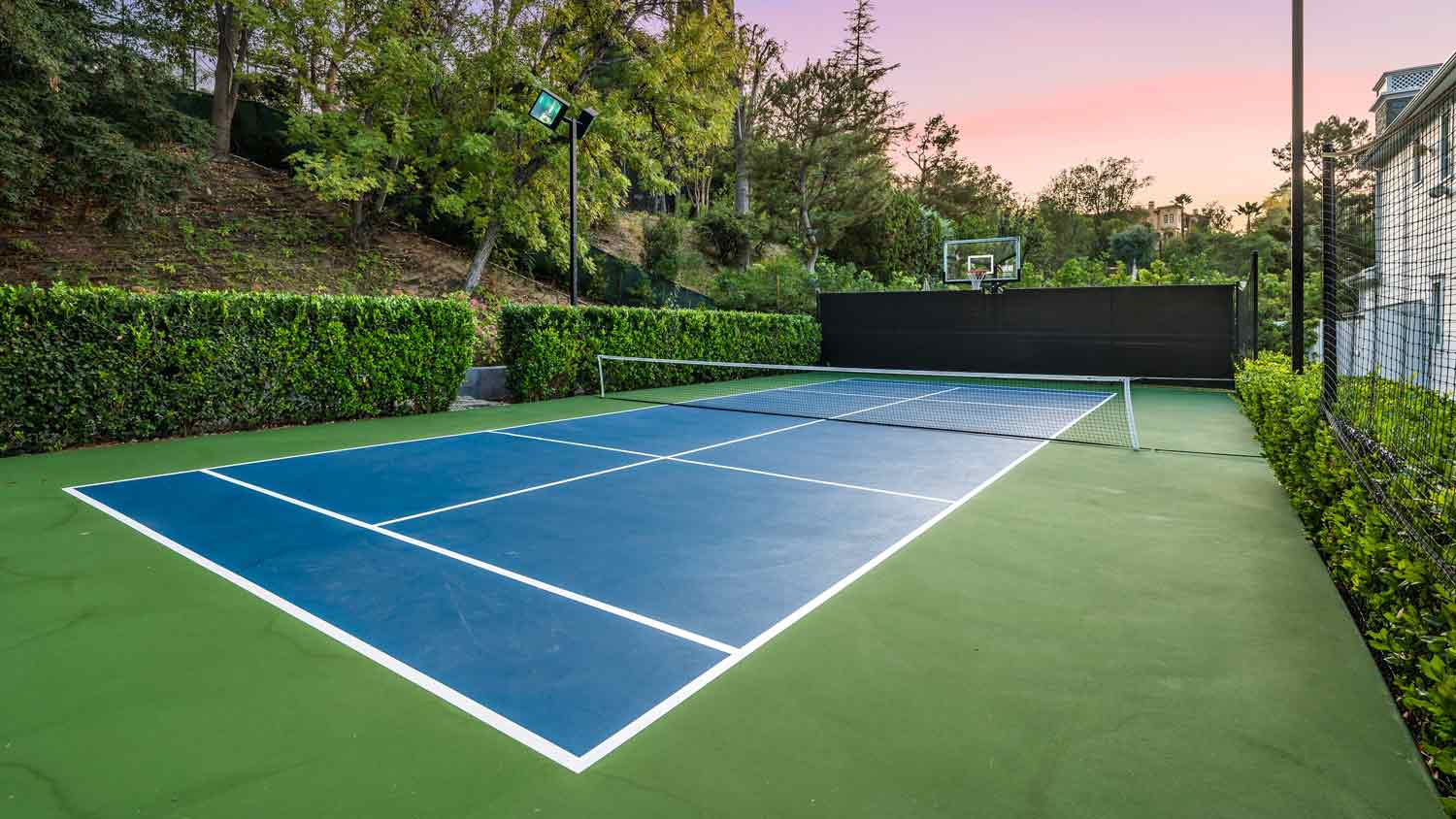
The right tennis court size depends on several factors, including how the court will be used and the space available. Whether you're building a regulation court or something smaller for recreational play, here are some key factors to consider.
Intended Use
The right size depends on how the court will be used. If the court is for professional or regulation play, it needs to follow USTA and ITF regulations with proper dimensions and clearance. However, recreational courts can come in a wide range of sizes depending on player needs.
Available Space
The biggest limiting factor when it comes to tennis court sizes is the space available. A full-sized court, including proper clearance, takes up a significant amount of land. If space is tight, the court may need to be scaled down, especially for backyard or recreational use.
Location Restrictions
Zoning laws, property lines, and neighborhood regulations may limit how large a court can be. For instance, some areas have rules about how close a court can be to a property boundary or may require permits for installation. Checking these early can prevent problems down the road.
Intended Player Type
Courts designed for adults need larger dimensions, while courts for kids can be smaller. If multiple age groups will be playing on the court, then it’s a good idea to design a flexible setup with blended lines that can accommodate different ages and needs.
Fence and Lighting
If the court will have fencing, lighting, or windscreens, make sure to factor them into the overall size of the court. Fencing should be placed far enough away from the playing area to prevent interference and lighting poles should be carefully positioned so they don’t create blind spots or hazards.
Budget
Your budget is an important size factor because the cost to build a tennis court increases with larger courts as they require more labor, time, and materials to construct. For instance, it typically costs between $20 and $125 per square foot to build an indoor tennis court. Factoring in costs for surfacing, fencing, and maintenance can help you figure out which size makes the most sense for your needs and budget.
What to Do if You Have the Wrong Size Tennis Court
A tennis court that’s the wrong size can lead to problems with gameplay, safety, and overall usability. For instance, if it’s too small, players may not have enough room to move comfortably or freely, especially near the baselines and sidelines. If it’s too large, it can take up more space than expected, increase your maintenance costs, and require additional fencing or lighting to cover the full area.
Fixing a court that’s the wrong size depends on the issue. If the playing area is too small, there may be ways to extend the surface or adjust clearance space if enough room is available. If it’s too large for the property, resurfacing the court or repainting the lines to a smaller size is often an option.
In some cases, adjustments like adding blended lines, installing a multi-purpose net, or changing the surface layout can make an imperfect court more functional without major reconstruction. When in doubt, consult with a tennis court contractor to help you determine whether modifications are possible or if a full rebuild makes more sense.
How to Prepare for Tennis Court Construction
Before construction starts, check your local zoning laws and permit requirements, since some areas regulate court placement, fencing, and lighting. Also, make sure the site you plan to build the court on is level and has proper drainage, since uneven ground or poor water management can lead to cracks, puddles, or shifting over time.
You should also decide on the court’s surface type early since different materials require different foundations and maintenance. For instance, concrete and asphalt courts need a solid base, while clay courts require subsurface drainage. If you’re adding fencing, lighting, or windscreens, factor them into the overall layout to avoid issues with placement later.
Common Mistakes When Sizing a Tennis Court
A tennis court that isn’t sized correctly can lead to frustrating gameplay, wasted space, and expensive fixes. Here are some of the biggest pitfalls to watch out for.
Not Enough Clearance: Just because a court fits within a property doesn’t mean there’s enough room to play. You’ll need proper clearance around the court, otherwise, gameplay can feel cramped, and shots near the edges become harder to return.
Misplacing the Net Posts: Net posts should be positioned 3 feet outside the sidelines to ensure the net is properly tensioned and aligned. If they’re too close or too far apart, it can completely throw off gameplay and require costly adjustments.
Ignoring Site Conditions: A court that isn’t built on level, well-drained ground will develop cracks, shifting surfaces, and puddles over time. Even a slight slope can affect ball bounce, so grading and drainage should be carefully addressed before construction begins.
Overlooking Fencing and Lighting Placement: Fences that are too close to the court can interfere with play, while poorly placed lighting can create glare or shadows that make it harder to track the ball. Planning these details upfront prevents costly repositioning later.
Choosing the Wrong Size for the Purpose: A full-size court isn’t always the best choice. For casual play, junior training, or multi-sport use, a smaller or modified court might be the better option. Trying to squeeze a regulation court into a space that’s too small can cause safety issues and make maintenance more difficult.

